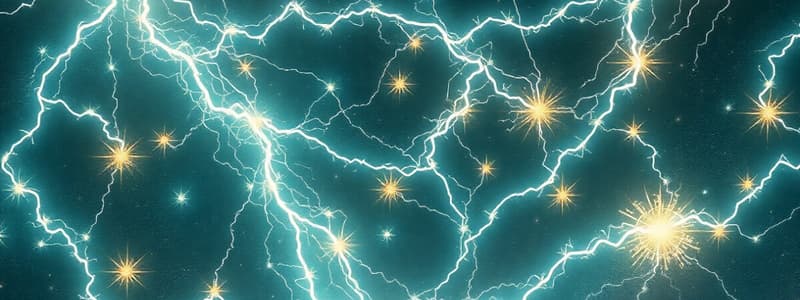Podcast
Questions and Answers
What does electrostatics deal with?
What does electrostatics deal with?
Electrostatics deals with stationary or static charges.
What does electricity deal with?
What does electricity deal with?
Electricity deals with the flow of electric charge (often electrons) through a conductor such as a wire.
What type of current flows in one direction?
What type of current flows in one direction?
- AC
- DC (correct)
What type of current changes periodically?
What type of current changes periodically?
How can electrostatics occur?
How can electrostatics occur?
What happens when one object loses electrons and the other gains electrons?
What happens when one object loses electrons and the other gains electrons?
What is the method of charging an object without direct contact called?
What is the method of charging an object without direct contact called?
If a neutral object is then grounded, charges may escape, leaving a net charge.
If a neutral object is then grounded, charges may escape, leaving a net charge.
What happens if you bring a negatively charged rod towards a neutral metal sphere?
What happens if you bring a negatively charged rod towards a neutral metal sphere?
Flashcards
Electrostatics
Electrostatics
The study of stationary electric charges and their interactions.
Electricity
Electricity
Deals with the flow of electric charge, typically through a conductor.
DC (Direct Current)
DC (Direct Current)
Electric current that flows in only one direction.
AC (Alternating Current)
AC (Alternating Current)
Signup and view all the flashcards
Electrostatics by Friction
Electrostatics by Friction
Signup and view all the flashcards
Electrostatics by Induction
Electrostatics by Induction
Signup and view all the flashcards
Electrostatics by Conduction
Electrostatics by Conduction
Signup and view all the flashcards
Grounding (Earthing)
Grounding (Earthing)
Signup and view all the flashcards
Electric Force
Electric Force
Signup and view all the flashcards
Electric Field
Electric Field
Signup and view all the flashcards
Coulomb's Law
Coulomb's Law
Signup and view all the flashcards
Conductor
Conductor
Signup and view all the flashcards
Insulator
Insulator
Signup and view all the flashcards
Potential Difference (Voltage)
Potential Difference (Voltage)
Signup and view all the flashcards
Electric Current
Electric Current
Signup and view all the flashcards
Resistance
Resistance
Signup and view all the flashcards
Electric Circuit
Electric Circuit
Signup and view all the flashcards
Proton
Proton
Signup and view all the flashcards
Electron
Electron
Signup and view all the flashcards
Neutron
Neutron
Signup and view all the flashcards
Study Notes
- Electrostatics deals with stationary or static charges.
- It focuses on forces and interactions between stationary charges, using Coulomb's law.
- It also addresses electric fields and potentials created by stationary charges.
- Electricity involves electric charge flow, often electrons, through a conductor like a wire.
- Dynamic charges mean that charges are in motion, often driven by electric field by a potential difference.
- DC is flow in one direction.
- AC flow changes periodically.
Electrostatics by Friction
- Friction occurs when two objects are rubbed together.
- Electrons either transfer from one object to another, depending on their tendency to lose or gain electrons.
- Usually, one object loses electrons, becoming positively charged. The other gains electrons, becoming negatively charged.
- Example: Rubbing a balloon on your hair causes your hair to become positively charged and the balloon to become negatively charged, resulting in electrostatic attraction.
Electrostatics by Induction
- Induction is a charging method without direct contact.
- A charged object is brought near a neutral object, causing a redistribution of charges in the neutral object.
- This occurs because the charged object exerts an electric field on the neutral object, causing its charges to move.
- If the neutral object is then grounded (connected to the earth), some charges may escape, leaving a net charge
Electrostatics by Conduction
- If bringing a negatively charged rod towards a neutral metal sphere the sphere's electrons are repelled away from the rod.
- The closer side to the rod is positively charged.
- If grounding the sphere some of the excess electrons will flow away leaving a net charge.
Studying That Suits You
Use AI to generate personalized quizzes and flashcards to suit your learning preferences.




